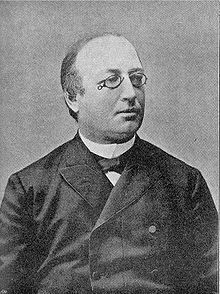Erik Gustaf Boström
| Erik Gustaf Boström | |
|---|---|
 |
|
| 7th Prime Minister of Sweden | |
|
In office 10 July 1891 – 12 September 1900 (9 years, 64 days) |
|
| Monarch | Oscar II |
| Preceded by | Gustaf Åkerhielm |
| Succeeded by | Fredrik von Otter |
|
In office 5 July 1902 – 13 April 1905 (2 years, 282 days) |
|
| Monarch | Oscar II |
| Preceded by | Fredrik von Otter |
| Succeeded by | Johan Ramstedt |
| Personal details | |
| Born |
11 February 1842 , |
| Died | 21 February 1907 (aged 65) Stockholm, Stockholm County |
| Political party | Lantmanna Party |
| Alma mater | Uppsala University |
Erik Gustaf Bernhard Boström (11 February 1842 – 21 February 1907) was a Swedish landowner and politician who was a member of the Swedish Parliament (1876–1907) and the longest-serving Prime Minister of Sweden of the 19th century. He served twice, first from 1891 to 1900 and then again from 1902 to 1905. He was also known as E.G. Boström or E. Gust. Boström.
In 1871, he married Carolina "Lina" Almqvist, with whom he had six daughters and one son. Brother of County Governor Filip Boström and nephew of the philosopher Christopher Jacob Boström.
Boström’s governmental policy was marked by its pragmatism. Over time, Boström gained a good reputation as being a rallying national icon despite being the first prime minister to have neither an academic education nor experience with upper governmental positions. He was also quite popular with King Oscar II. Boström’s eventual downfall was caused by his refusal to budge on the issue of Norway.
Erik Gustaf Boström was born in , the son of Eric Samuel Boström, chief judge of the district court and his wife Elisabet Gustava Fredenheim. The family was one branch of the Laestadius family of priests from Norrland. His paternal grandfather Christopher Laestander, a townsman and ship carpenter in the city of Piteå, took the surname Boström.
He was tutored by Kristian Claëson, whose first cousin served as the Minister of Ecclesiastical Affairs under Boström in 1898. In 1854, he became a student at the Uppsala Cathedral School, which was also the year his father died. It is worth noting that five of his fellow cabinet members during his first term attended the same school: Axel Rappe, Edvard von Krusenstjerna, Ludvig Annerstedt, Gustaf Gilljam and Lars Åkerhielm. In 1861, he transferred to Uppsala University, where he studied until 1863 when his mother died and he had to take over her manor Östanå.
...
Wikipedia
